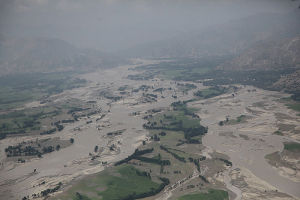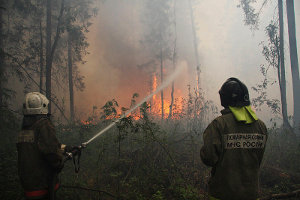The summer of 2010: deadly catastrophes
Among the countries hardest-hit by this outburst of nature, we find Pakistan, inundated by the worst floods in its history, Russia, shaken by a wave of unprecedented heat and huge forest fires and China, which has experienced its worst landslides in a decade.
 Following torrential monsoon rains, which occurred on July 29, Pakistan has undergone one of the worst disasters of its history given the scale of the damages it has sustained. Nearly a fifth of the territory was flooded and more than 3.6 million hectares of farmland have been damaged, that is, 14% of cropped lands, according to the United Nations.
Following torrential monsoon rains, which occurred on July 29, Pakistan has undergone one of the worst disasters of its history given the scale of the damages it has sustained. Nearly a fifth of the territory was flooded and more than 3.6 million hectares of farmland have been damaged, that is, 14% of cropped lands, according to the United Nations.
At the humanitarian level, the floods have killed at least 1760 people, more than 21 million victims, 10 millions of whom have been made homeless, according to figures released by the UN in early October 2010. The economic consequences of the disaster are poised to be substantial. The total losses are likely to reach 43 billion USD, according to the Pakistani ministry of foreign affairs. In the meantime, the agricultural sector will suffer damages worth 3 billion USD.
China mourns 1435 dead following the heavy rains that washed the north western part of the country. On August 8, severe bad weather caused landslides and mudslides that have affected 305 million people and caused material losses amounting to 1.7 billion USD.
 © RIA Novosti,CC BY-SA 3.0 © RIA Novosti,CC BY-SA 3.0 |
The situation is not any better in Russia. The country has experienced the highest heat wave in a 1000 years with abnormally high temperatures (around 40 degrees during six weeks) resulting in unprecedented forest fires.
As a result, the blaze has ravaged 1.6 million acres, destroyed a third of the grain harvest, burned whole villages and left 3 500 people homeless. According to an official toll published in late August, the economic cost of this disaster, which killed 54 people, could reach 14 billion USD, that is, 1% of Russia's GDP.
Other special events occurring in different locations around the globe are worth mentioning: floods in India, bad weather in Central Europe, cold weather and snowfall in Argentina, melting polar ice with the detachment of an iceberg of more than 250 square kilometers from Greenland.
Global warming, the culprit
For climatologists, this sequence of extreme events is a sign of climate disruption, caused by global warming, pollution and greenhouse gas emissions. Same story for the reinsurer Munich Re which attributes the increase of extreme events to global warming. According to experts' analyses, storms and floods have tripled since 1980 and are poised to recur and intensify in an environment affected by pollution.
The major natural catastrophes between June and August 2010
| Country | Date | Catastrophe | Human losses | Economic losses |
|---|---|---|---|---|
The var, France | 15&16 June | Floods | 23 dead, 266 000 affected | 1.3 billion USD of losses among which 1 billion of insurable properties |
Russia | July-August | Forest & peat bog fires | 54 dead, 3500 affected | 14 billion USD of losses, 1.6 million of devastated hectares |
Pakistan | July-August | Exceptional monsoon, severe floods | 1760 dead, 21 million affected | 43 billion USD of losses, 20% of the territory is flooded |
India | 6 August | Heavy rain | 190 dead, 400 missing, thousands of injured | - |
Central & Eastern Europe | 6&7 August | Floods | 15 dead | - |
China | 8 August | Floods & mudslide | 1435 dead, 330 missing | 1.7 billion USD of losses |